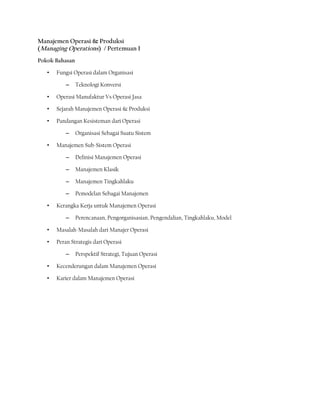Pert 1
- 1. Manajemen Operasi & Produksi (Managing Operations) / Pertemuan I Pokok Bahasan • Fungsi Operasi dalam Organisasi – Teknologi Konversi • Operasi Manufaktur Vs Operasi Jasa • Sejarah Manajemen Operasi & Produksi • Pandangan Kesisteman dari Operasi – • Organisasi Sebagai Suatu Sistem Manajemen Sub-Sistem Operasi – – Manajemen Klasik – Manajemen Tingkahlaku – • Definisi Manajemen Operasi Pemodelan Sebagai Manajemen Kerangka Kerja untuk Manajemen Operasi – Perencanaan, Pengorganisasian, Pengendalian, Tingkahlaku, Model • Masalah-Masalah dari Manajer Operasi • Peran Strategis dari Operasi – Perspektif Strategi, Tujuan Operasi • Kecenderungan dalam Manajemen Operasi • Karier dalam Manajemen Operasi
- 2. Fungsi Operasi dalam Organisasi Beberapa Terminologi • Sistem operasi : bagian dari organisasi yang menghasilkan produk barang dan jasa organisasi • Proses konversi : proses yang merubah input menjadi output • Nilai tambah : peningkatan nilai karena proses konversi dimana output > input • Random fluctuations : pengaruh lingkungan yang tidak dapat dikendalikan • Umpan balik : informasi dlm proses kontrol yg memungkinkan bagi manajemen untuk memutuskan apakah kegiatan organisasi memerlukan penyesuaian • Technology : tingkat kecanggihan pengetahuan dlm proses konversi (pabrik, peralatan dan ketrampilan) Sistem Operasi pada Toko Swalayan
- 3. Sistem Operasi pada Usaha Pertanian Perubahan Paradigma : Manajemen Proses
- 4. Perubahan Paradigma : Manajemen Proses Belajar-Mengajar
- 5. Operasi Manufaktur Versus Jasa : Produksi Versus Operasi Perbedaan Barang dgn Jasa Ciri-Ciri Barang • Produk berwujud • Produk bisa dijual kembali • Produk bisa disimpan • Produksi terpisah dgn konsumsi • Aspek mutu mudah diukur • Penjualan terpisah dgn produksi • Produk bisa diangkut • Fasilitas penting utk biaya • Mudah melakukan otomatisasi • Penerimaan dihasilkan dariproduk Ciri-Ciri Jasa • Produk tidak berwujud • Jasa sulit dijual kembali • Banyak jasa tdk bisa disimpan • Produksi dan konsumsi bisa secara simultan • Banyak aspek mutu sulit diukur
- 6. • Penjualan menjadi bagian dari jasa • Interaksi pelanggan tinggi • Penyedia, bukan produk, bisa diangkut • Fasilitas penting untuk kontak pelanggan • Sulit untuk melakukan otomatisasi • Penerimaan dihasilkan dari kumpulan jasa Barang Versus Jasa Sejarah Tahun Kontribusi Kontributor 1776 Spesialisasi tenaga kerja di pabrik Adam Smith 1832 Pembagian tenaga kerja; penugasan berds ketrampilan Charles Babbage 1900 Scientific management; time study and work Frederick W Taylor 1900 Motion study of jobs Frank B Gilberth
- 7. 1901 Schedulling techniques for employee, machines and job Henry L Gantt 1915 Economic lots sizes for inventory control F.W. Harris 1927 Human relations; the Hawthorne studies Elton Mayo 1940 Operation research applications in WW-II PMS Blacket, dkk 1946 Digital computer John Mauchly & JP Eckert 1947 Linier programming GB Dantizg, dan lainnya 1950 Mathematical programming, non linier & stochastic A.Chanrnes, WW Cooper 1951 Commercial digital computer; large-scale are available Sperry Univac 1960 Organizational behaviour; Study people at work L. Cumming; L.Porter 1970 Integrating operation into overall strategy & policy W. Skinner 1980 Quality and productivity application from Japan WE Deming & J. Juran Pandangan Kesisteman Manajemen Sub-Sistem Produksi Klasik Scientific Management Asumsi-Asumsi • People motivated by economic alone • Mangerial Fokus Utama • Economic efficiency • Physical aspecs of work environment Kontribusi terhadap Manajemen Demonstration of benefits from specialization of labor, division of labor, job analysis, separation of
- 8. rationality • Process Orientation • Organization a closed system Scientific analysis of work task • Application of techniques to work tasks Management activities separable Management processes planning and doing Indentification of principles and function of management Manajemen Sub-Sistem Produksi Asumsi-Asumsi Fokus Utama Kontribusi terhadap Manajemen Human Relations People complex; possess multiple needs Behavior of individual in work environment Awareness of individuals Behavioral Science Human being sosial creatures Interpersonal and social aspects of work environment Indentification of behavioral variables that relate to organisational behavior Social Systems Organisation an open system Interactive relationships of organisation with its environment Development of theories relating oragnisational behavior to human characteristics and organisational variables Behavioral Manajemen Sub-Sistem Produksi Modelling Asumsi-Asumsi Fokus Utama Kontribusi terhadap
- 9. Manajemen Decision making Decision making process are the primary managerial behaviors System theory • • Mathematical modelling Organisation an open system Organisation an complex interrelated subcomponents Main elements of organisation can be abstracted, interrelated and expressed matehematically Information acqusition, utilisation and choice processes Development of guides for improving decision making Identification of organisation boundaries, interrelationships among subsystems and organisation and larger environment Devel;opment of approaches for predicting and explaining system behavior • Quantification of decision problems and systems • Optimizing of small set of situations • Development of explicit rules for management decisions • Development of methods for analysing organisation systems or subsystems Pendekatan Klasik • Efisiensi Organisasi (%) : • Process Management Output/Input x 100% Kerangka Kerja untuk MOP • Planning : activities that establish a cource of action and guide future decision making • Organising : activities that establish a structure of tasks and authority • Controlling :activities that assure that actual performance is in accordance with planned performance • Behavior : how planning, organising and controlling affect human behavoir
- 10. • Modelling : use to simplify real-world Kerangka Kerja untuk MOP Masalah-Masalah dalam MOP % Activity % Activity 90.6 Production planning 48.1 Lead time reduction 76.9 Supervisor training 47.5 Quality circles 66.3 Capacity expantion 46.9 Developing new processes for old product 63.1 Worker safety program 46.3 Automating jobs 58.8 Defining manufacturing strategy 44.4 Developing new process for new product 57.5 Motivating direct labor employees 43.1 Vendor relations, procurement 55.0 Value analysis-product redesign 42.5 Focusing factories 54.4 Improved maintenance practices 41.3 Narrowing product line 53.1 Changing manufacturing organisation 39.4 Making existing system work better 51.3 Changing labor/management relationship 35.0 Giving workers a broader range of tasks to perform 50.0 Developing integrated infrormation system 33.1 CAD
- 11. Peran Strategis MOP Model Umum Manajemen Operasi











